Round-up: 3 extreme 8-string electric guitars
Downtuned metal monsters reviewed, compared
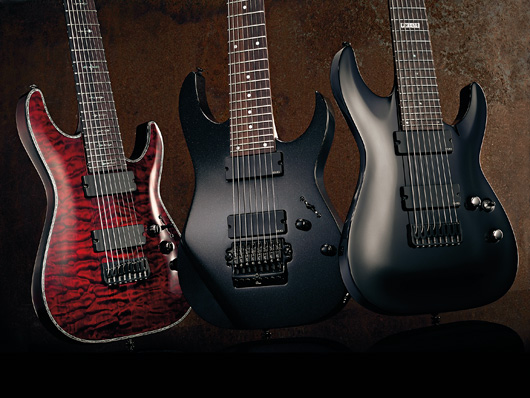
3 extreme 8-string electric guitars (£899-£1699)
Guitars with more than six strings have been around for centuries. For example, the lute - a bowl-backed instrument popular during Elizabethan times - sometimes had its 12-strings augmented by a further four bass strings. The mandolin traditionally offers eight strings, while Martin trumpeted the 000-12 harp guitar back in 1902 - probably the very first double-neck - that comprised a total of 18 strings!
In 1964 Rickenbacker presented a one-off 12-string version of the short-scale 325 to John Lennon - even though he rarely grabbed it from its case - and introduced the 450/12 later that same year. Lennon's bandmate George Harrison had earlier been given the second 360/12 ever made and, along with Roger McGuinn of The Byrds, he would go on to define the electric 12-string sound and style in the mid-to-late 1960s.
However, each instrument mentioned has one thing in common; their strings doubled the standard six, whether tuned to the same pitch or, in the case of a traditional 12, had the four bass strings an octave above their parent.
"About as extreme as it can get"
Here we’re concerned with guitars that have strings that have their own identity, as it were, and we reckon eight independent strings on a single neck is about as extreme as it can get, especially for mainstream guitars.
Seven-strings are familiar beasts these days - in fact arguably the most famous of all, Steve Vai’s Ibanez Universe, celebrates its 20th anniversary this year. For all our searching and resource-scouring, production eights are few and far between. All three of these models are available for the mainstream market and subsequently neither command a custom-order price nor require you to wait months for it to be constructed.
For the purposes of this review, all three have been tuned to standard 8-string intervals - low to high, F#, B, E, A, D, G, B, E - although we should point out that the Ibanez has a factory tuning that’s down a further half step (F to Eb).
Each has its own slightly different scale length, which is certainly interesting, and all are fitted with a set of EMG-808 humbuckers, the only such pickup available prior to Winter NAMM 2010, when Seymour Duncan announced the 8-string version of its active Blackout pickups.
We’d assumed that the three guitars here would be much of a muchness, but that couldn’t be further from the truth. Who knew that the world of the 8-string solidbody electric could be so diverse?
First up: Ibanez RG2228 Prestige price and spec

Ibanez RG2228 Prestige price and spec
Specifications
Price: £1699 (inc. case)
Origin: Japan
Body: Basswood
Neck: Five-piece maple/wenge laminate
Fingerboard: Rosewood, 24 jumbo frets
Scale: 685.8mm (27-inch)
Nut/width: Locking/54mm
Hardware: FX Edge III-8 fixed bridge, locking nut, Ibanez tuners
Electrics: Two EMG-808 humbuckers, volume, tone, three-way toggle
Finish: Galaxy black only
Next: Ibanez RG2228 Prestige build and features
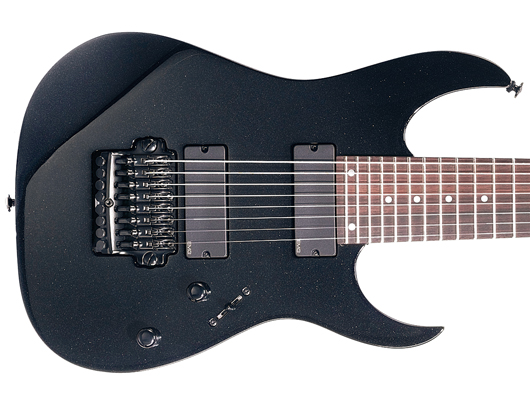
Ibanez RG2228 Prestige build and features
Build and features
The RG2228 is a member of the exclusive Japanese-made Prestige Series and features a neck of standard baritone scale at 686mm (27-inches). It’s constructed from a five-piece sandwich comprising maple and wenge: a tropical tonewood not too far removed from ebony. It’s been left unfinished.
As this is a Wizard neck, it’s very thin - just 20mm depth at the first fret - which helps counteract the unavoidably hefty width - 54mm at the nut. Uniquely, the guitar sports a locking nut, complete with four plates rather than the more familiar three, and the Edge-III bridge bristles with an octet of fine tuners.
It’s also worth emphasising that the guitar is factory tuned half a step further down, running from F to Eb, low to high, and is strung with a 0.009-0.065 set. Why the locking nut? We’re not entirely sure, other than negating a well cut nut for tuning stability and maintaining the Ibanez ‘norm’.
Next: Ibanez RG2228 Prestige sounds, pros and cons
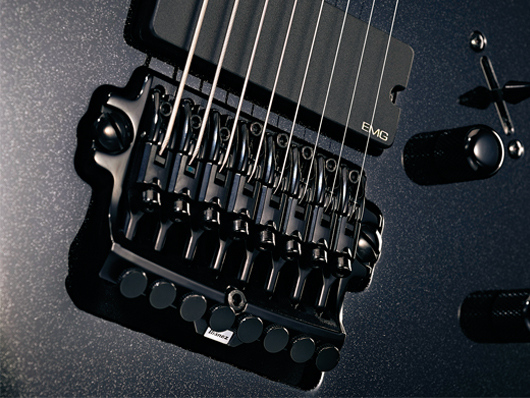
Ibanez RG2228 Prestige sounds, pros and cons
Sounds
The RG’s ultra-thin neck does make it the easiest guitar to get to grips with here, especially if you play with your thumb rooted to the centre of the neck. As ever, the ergonomic RG body shape is a pleasure to caress and, as eights do tend to waver in and out of pitch until the strings settle, the fine-tuners here make for a convenient tuning method.
The longer scale also allows for the firmest string tension, which allows hardcore riffing on the low strings to not only be particularly precise but also to have the clearest notes.
Pros: Great neck and performance; excellent build quality.
Cons: The price, to a certain extent, but the guitar is worth it.
4.5 out of 5
Verdict: The Ibanez J-Custom team have produced yet another innovative and eminently playable guitar. We just can’t put it down.
Next: ESP LTD FM-418 price and spec
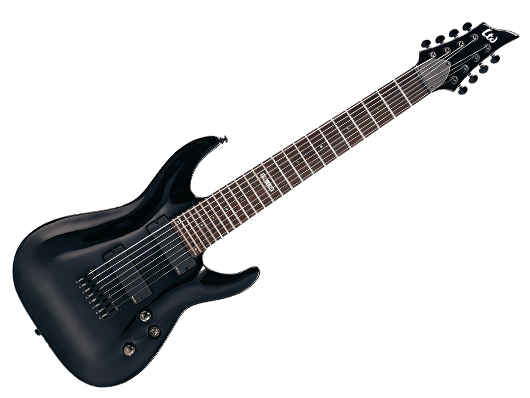
ESP LTD FM-418 price and spec
Specifications
Price: £1189
Origin: Indonesia
Body: Basswood
Neck: Maple
Fingerboard: Rosewood, 24 jumbo frets
Scale: 660mm (26-inch)
Nut/width: Graphite 55mm
Hardware: Hipshot 8 bridge, locking nut, Grover tuners, all black
Electrics: Two EMG-808 humbuckers, volume, tone, three-way toggle
Finish: Black only
Next: ESP LTD FM-418 build and features
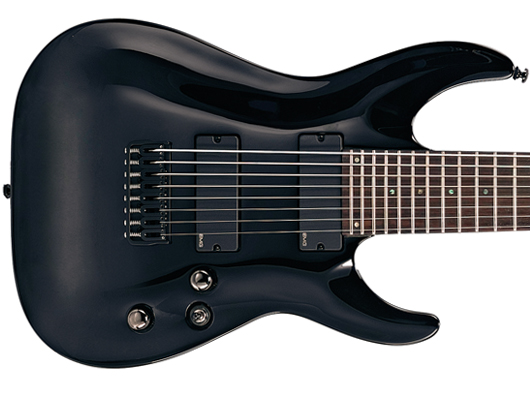
ESP LTD FM-418 build and features
Build and features
The ESP line contains the only production signature eight-string that we’re aware of, Steph Carpenter’s STEF-B8, and although there is a version available in the cheaper LTD range too, this FM, which bears the body of an M Series guitar alongside the headstock of an F Series, is a standalone mainstream eighter.
Manufactured in Indonesia, the FM offers the shortest scale of the three (660mm/26-inches), which, in theory at least, will give the floppiest string tension, and a 55mm-wide graphite nut adorns the nicely proportioned headstock. The neck is fatter than that of the Ibanez and is factory strung to pitch with a set of 0.010-0.068 wires.
Again, pickups comprise an EMG-808 set, which are controlled by master volume and tone controls, plus a standard three-way toggle selector, and the LTD is one of two protagonists here to feature a Hipshot 8 bridge.
If we were to split hairs, we’d bemoan the lack of the ultra-metal ESP pointed headstock, but this is a nicely made eight-stringer that’s very comfortable to play.
Next: ESP LTD FM-418 sounds, pros and cons
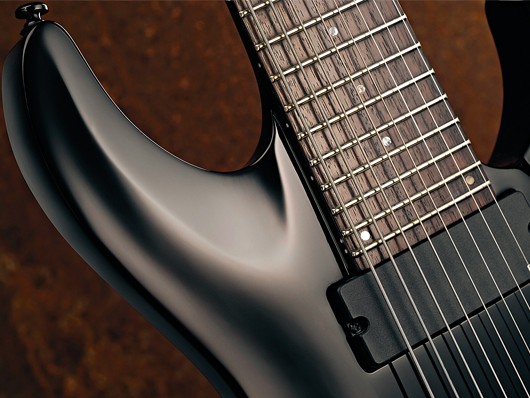
ESP LTD FM-418 sounds, pros and cons
Sounds
In fact the more compact scale length does make the LTD feel slightly more conventional when compared with the others, which in turn makes it simpler to keep track of where your fingers are at any one time.
Offering a nicely tight tone overall, the floppy F# string does make defined riffs slightly trickier to control, although with extreme gain settings Zakk Wylde-style bent pinched harmonics do resemble whale song: a good thing.
The neck pickup gives a cool solo tone, the techniques for which are aided by the looser string tension, while the toggle’s central position is great for cleaner passages.
Pros: Shorter and more comfortable scale; floppy string tension feels great…
Cons: …but can cause tuning issues if you hit the strings too hard.
4 out of 5
Verdict: A perfectly good 8-string that's an option for those who don't like to struggle to play.
Next: Schecter Hellraiser C-8 price and spec
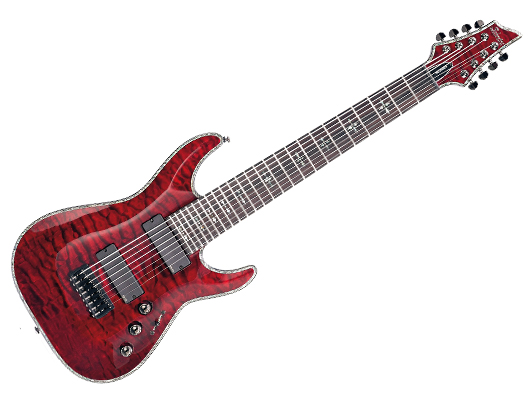
Schecter Hellraiser C-8 price and spec
Specifications
Price: £899
Origin: South Korea
Body: Mahogany, quilted maple top
Neck: Mahogany
Fingerboard: Rosewood, 24 jumbo frets
Scale: 673mm (26.5-inch)
Nut/Width: Tusq/54mm
Hardware: Hipshot 8 bridge, Schecter locking tuners, all black chrome
Electrics: Two EMG-808 humbuckers, volume, tone, three-way toggle
Finish: Black cherry only
Next: Schecter Hellraiser C-8 build and features
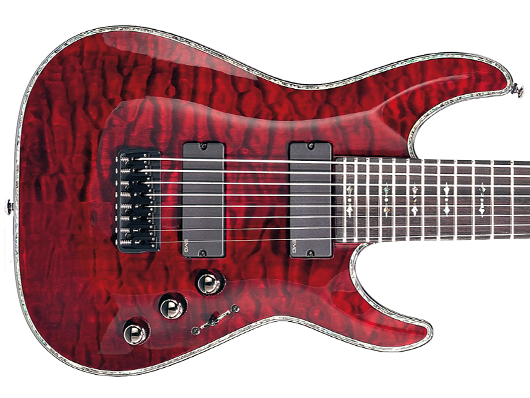
Schecter Hellraiser C-8 build and features
Build and features
We’ve covered several examples of Schechter’s Hellraisers over the past couple of years and no less than two 8-strings can be found among their number. As is the cornerstone of the Hellraiser spec, the body is mahogany with a quilted maple top, outlined with abalone binding. A three-piece mahogany neck includes the Ultra Access heel and wears its dark metal heart on its rosewood sleeve with a smattering of Gothic Cross inlays on the fingerboard.
With a 26.5-inch scale that sits between the length of the other guitars here, the Schecter headstock is, if anything, a little crowded with the D and A tuners almost - but not quite - touching each other.
It’s arguably the most traditional in feel, too, with the ’board edges slightly squarer. That said, the sheer width of any eight-string neck does away with virtually any chance of playing with your thumb over the top of the fretboard, but it does play agreeably.
The two EMGs are controlled by individual volume pots plus a single tone and three-way toggle selector, and we have to say that - not for the first time - grabbing the central knob to turn the bridge pickup’s volume off is made needlessly vexing due to its positioning
Next: Schecter Hellraiser C-8 sounds, pros and cons
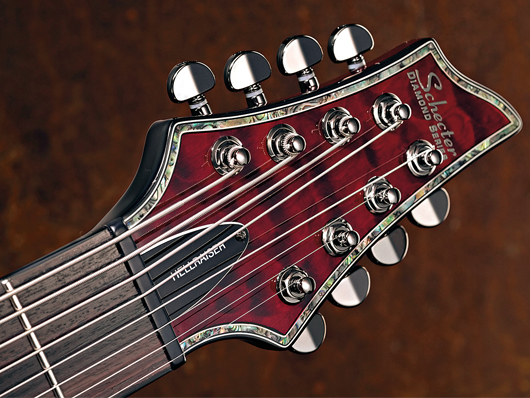
Schecter Hellraiser C-8 sounds, pros and cons
Sounds
It’s the only guitar here with a mahogany body, so is this the reason for its darker voice? Quite possibly, it certainly is dark compared to the other two and provides a crushing metal-tone: think Meshuggah injected with lead.
Both the maple top and the active pickups contribute to a high-end boost that lets the huge tone cut when required, and clean it’s probably the best of the bunch: adding a touch of chorus and delay to the neck pickup gives a lovely sparkling tone for augmented and suspended chords.
Pros: Cool looks; huge tone; good price.
Cons: Crowded headstock; not much else.
4 out of 5
Verdict: An impressive and attractively priced eight-string with looks that set it apart.
Next: The verdict - which 8-string is best?

The verdict - which 8-string is best?
Verdict
We’ve very much enjoyed our foray into the world of the 8-string, and heartily recommend them to those of you with the resources, patience and talent to give one a go. It takes about an hour’s worth of faltering playing before your brain catches up with your fingers and you stop fretting one string while picking another. Once up to speed, however, you’ll soon stumble on some cool chord voicings to add to your repertoire.
If we were to choose just one of these guitars, we’d plump for the Ibanez RG2228 because its longer scale length gives it the edge as far as playability is concerned. The Prestige range is always excellently put together and this example is no different. It has a lovely neck that’s thin enough to encourage experimentation, and the ergonomic RG body shape will always have a place in our hearts. Yes, it’s the priciest, but it’s also the only one to include a high-spec flight case and we feel it’s well worth the outlay.
That being said, both the Schecter and ESP models have enough differences about them to merit their own plaudits. With differing scale lengths that equate to looser string tensions, each guitar plays well, and if extreme metal is your style, we can heartily get behind the C-8’s mahogany body as its basic rhythm tone is truly gargantuan.
Marrying that 660mm (26-inch) scale with a basswood body, the ESP mixes what is arguably the most traditional playing experience with the most relaxed string tension and, as such, would be one to try if you have no clue what to expect from an eight.
The Schecter is excellently priced at under the £1000 mark but all three are well worth forking out for and our rule of thumb would be that the more experienced a player you are, the longer a scale your 8-string should have.
Uk luthier Paul Stevens offers a custom option called the Black Widow 8 with a 29.45-inch scale for £2220, which we’re eager to try, but for now we’ll continue to experiment with the lovely Ibanez RG2228.
Liked this? Now read: The 12 best amps for heavy metal
Connect with MusicRadar: via Twitter, Facebook and YouTube
Get MusicRadar straight to your inbox: Sign up for the free weekly newsletter
Simon Bradley is a guitar and especially rock guitar expert who worked for Guitarist magazine and has in the past contributed to world-leading music and guitar titles like MusicRadar (obviously), Guitarist, Guitar World and Louder. What he doesn't know about Brian May's playing and, especially, the Red Special, isn't worth knowing.